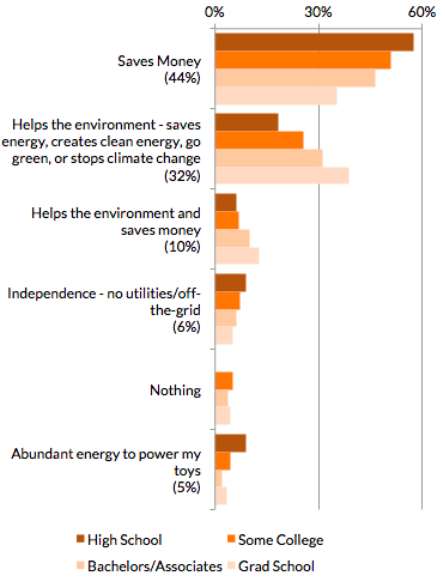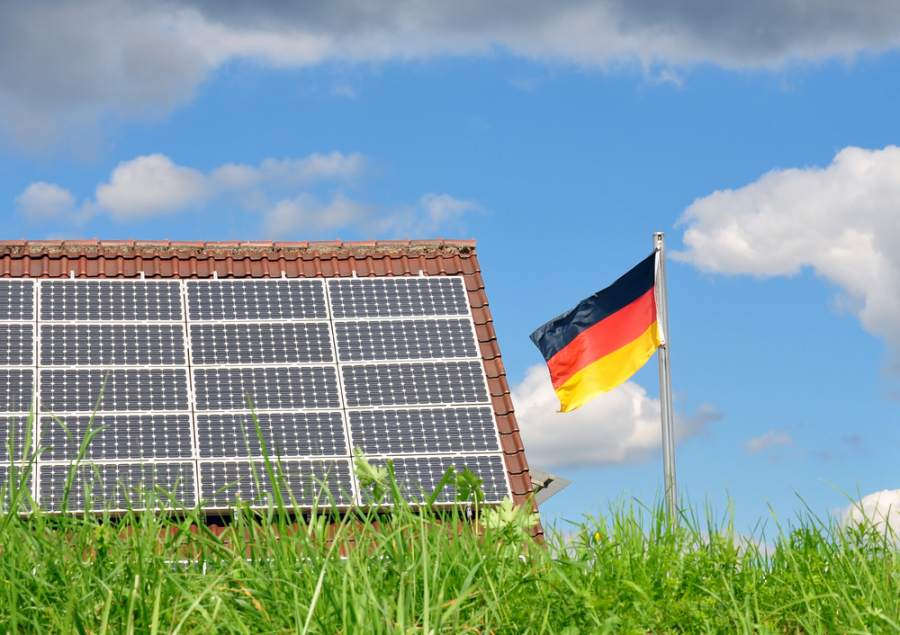When I began working at NIRS in 1985 solar power was just a dream. Oh sure, President Carter had put a few solar panels up at the White House (which President Reagan promptly took down, just to make sure everyone knew there would be no future in solar), and a few, mostly off-the-grid types had installed solar PV at their homes, which was expensive and sort of worked–especially if the homes weren’t too electricity-dependent. But solar power was a future energy source. It was way too expensive and not efficient enough for prime-time.
The same was true for wind power, for that matter. And even natural gas was just a blip on the nation’s electricity generation radar. Coal was dominant, providing well over 50% of the nation’s electricity. Nuclear was edging close to 20%, a figure it eventually reached but never topped (and now is back down to about 19% and falling). The rest was hydro, some gas, and even, back then, some oil.
The picture has changed today, of course. We don’t use oil for electricity production anymore–it’s not only dirty, it’s too expensive. Coal has slipped substantially (although it remains too high), with nuclear stagnant, natural gas has picked up much of coal’s portion of production.
But solar power is no longer a dream.
Indeed, before GreenWorld began publication in January, I had a strong interest in solar, but I didn’t try to follow it closely. Now I do. And I’m overwhelmed at the fast-moving developments in the industry–most of which we don’t post here; there is just too much.
 So it’s not surprising that a new poll–of 1,000 California homeowners who volunteered to participate–finds great confusion over the benefits of solar. After all, if I can barely keep up, how can the average person who doesn’t do this for a living?
So it’s not surprising that a new poll–of 1,000 California homeowners who volunteered to participate–finds great confusion over the benefits of solar. After all, if I can barely keep up, how can the average person who doesn’t do this for a living?
For example, the poll asked people to say the first thing that comes to their mind when they hear the words “solar power.” The top answer (at 17%): “It’s expensive.” The second answer (at 16%): “Save money.” Tied with “save money” was “skeptical.”
But when asked what they thought the most appealing thing about solar power is, 44% (by far the highest) said: “saves money.” 32% cited the environmental benefits of solar, while only 10% cited both environmental benefits and “saves money.” Interestingly, the higher the level of education, the less likely people were to say “saves money” and the more likely they were to tout environmental benefits. And yet, solar–especially in California but increasingly elsewhere does save money (and provides those environmental benefits too).
As the article accompanying the poll (and there are some other interesting questions and answers there too) concludes,
“When it comes to residential solar, people are still relying heavily on their perceptions. And we’ve seen how off those can be, especially given how much the solar landscape has been changing.
“That’s something we need to change. A key imperative for the solar industry has to be educating the public. The Solar Energy Industries Association (SEIA) has made a good start at this with their America Supports Solar campaign. Now we need to keep the momentum going and ensure Americans know that they can save money with solar. After all, that’s what people ultimately care about.”
But it’s not only the solar industry that has to do that education, it’s all of us who support a clean energy system. But it is difficult when solar power is evolving so rapidly. To give an indication of just how rapidly, here are just some of the key articles, with a few comments, we’ve come across just since Friday, or, counting the weekend, five days of solar power news:
*Even the conservative International Energy Agency (IEA) now projects that solar power will be the dominant source of electricity production globally by 2050. Oddly though, the IEA projects that will account for only 27% of generation.
“This might sound like some mighty radical thinking from what is one of the world’s most conservative energy organizations (it was established in the 1970s to devise policies to ensure a continuation of oil supplies), but in reality it is not.
“Solar PV, for instance, is likely to expand way beyond even the IEA’s most bullish scenarios, as a result of widespread deployment and continuing cost cuts. The IEA suggests that solar PV could account for 16 per cent of global generation by 2050, although this would require an average of more than 116GW of solar PV to be deployed over that time.
Its estimates, however, seem conservative given that most private forecasters suggest that the solar industry will reach 100GW installation a year anyway by 2017 or 2018, and capacity is likely to grow further beyond that. Its “vanilla” scenario for reaching its climate goals require just an average of 67GW of solar PV to be installed a year. The solar market is likely to reach that figure in 2015.”
IEA gets four stars for realizing solar will be king; but it loses two of them for not realizing solar will far exceed the 27% estimate.
*If there were any doubt IEA’s projections can be met, consider this: there are now 140 GW of solar projects already in the pipeline–that’s up 5 GW just since February. These are predominately utility-scale solar projects, not rooftop solar projects that are too small to be considered in the criteria for this report.
*China alone may exceed IEA’s estimates. The country now plans to install 70 GW of new solar by 2017, tripling its current world-leading capacity. “However, it’s worth noting that China has a history of setting “low” solar targets and then raising them. A few years ago, China’s 2015 solar target was 5 GW, then it doubled that to 10 GW, then it more than doubled that to 21 GW, then it nearly doubled that to 40 GW! This all occurred within the course of about 2 years. 70 GW by 2017 sounds impressive, but we’ll see if that isn’t increased yet again in the coming years.”
*Solar growth isn’t limited to China. One of the world’s largest solar projects is scheduled to come online in Pakistan later this year. At first, it will provide 100 MW of power, but when fully operational in 2016 will produce 1 GW–more than twice the size of the largest U.S. solar thermal plant. “The project might end up being a fair bit bigger than even that, though. After the inauguration, the Prime Minister immediately approved the expansion of the project — up to 1,500 MW capacity and 15,000 acres of coverage.”
*Over in “sunny” Scotland, a new report for the Scottish Parliament advocates building rooftop solar on 250,000 homes in the country, which would provide more than 16% of the nation’s electricity on its own. Even there, which has a similar solar potential as Germany (i.e., a similar solar potential as Alaska), solar is expected to be the cheapest source of electricity by 2025.
 *In Germany, the country most serious about renewable energy, the government last year began offering a subsidy to homeowners to install battery storage for their rooftop solar systems; more than 4,000 storage systems have since been installed. The cost? About $90 million in low-interest loans and $10 million in grants–figures that would not even show up in the U.S. federal budget.
*In Germany, the country most serious about renewable energy, the government last year began offering a subsidy to homeowners to install battery storage for their rooftop solar systems; more than 4,000 storage systems have since been installed. The cost? About $90 million in low-interest loans and $10 million in grants–figures that would not even show up in the U.S. federal budget.
*In the U.S., where the government is not so enlightened, a company called Mosaic has announced a new program to provide homeowners loans for purchase of rooftop solar installations that the company says would “have the lowest monthly payments of any home solar loan product that we know of on the market,” even lower than currently popular leasing programs. It’s a start, but we’d like to see Sen. Bernie Sanders’ (I-Vt.) 10 million solar rooftop legislation introduced last Congress enacted too.

*Finally, back to Germany, where they know not only how to support solar power installations, they know how to support clean energy in the streets. A pro-renewables rally last weekend in Berlin was expected to draw 10,000 people; 36,000 showed up, and from the videos included, they look like they had a great time (and kept the anti-nuclear flags flying as well).
Five days of solar power–and that’s not even including a number of other articles I didn’t cover; with this industry’s rapid growth, is it any wonder it’s hard to keep up? But that it’s so hard is very good news. Solar power isn’t a dream, it’s a reality.
Michael Mariotte
May 20, 2014
Permalink: https://www.nirs.org/2014/05/20/five-days-in-solar-news/
You can now support GreenWorld with your tax-deductible contribution on our new donation page here. PayPal now accepted. We gratefully appreciate every donation of any size–your support is what makes our work possible.
Comments are welcome on all GreenWorld posts! Say your piece above. Start a discussion. Don’t be shy; this blog is for you.
If you like GreenWorld, you can help us reach more people. Just use the icons below to “like” our posts and to share them on the various social networking sites you use. And if you don’t like GreenWorld, please let us know that too. Send an e-mail with your comments/complaints/compliments to nirs@nirs.org. Thank you!
Note: If you’d like to receive GreenWorld via e-mail daily, send your name and e-mail address to nirs@nirs.org and we’ll send you an invitation. Note that the invitation will come from a GreenWorld@wordpress.com address and not a nirs.org address, so watch for it.




Reblogged this on your passport to complaining and commented:
The essence of this article is that progress is happening so fast in solar power that it is hard for even people tracking it closely to keep up.
Thank for this informative run-down on solar today.
of course, you are welcome. Repost it if you think it is useful for others